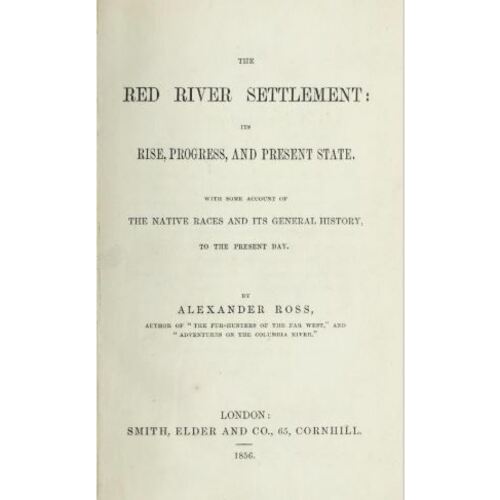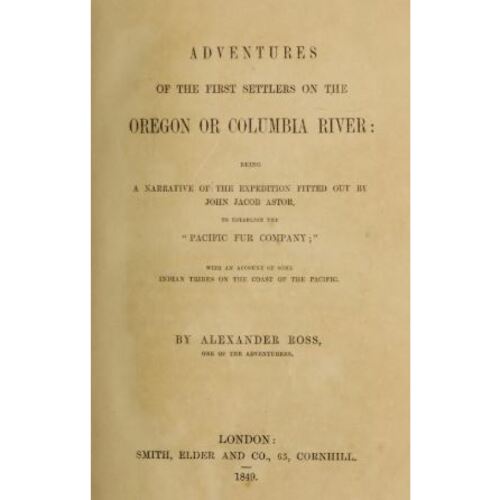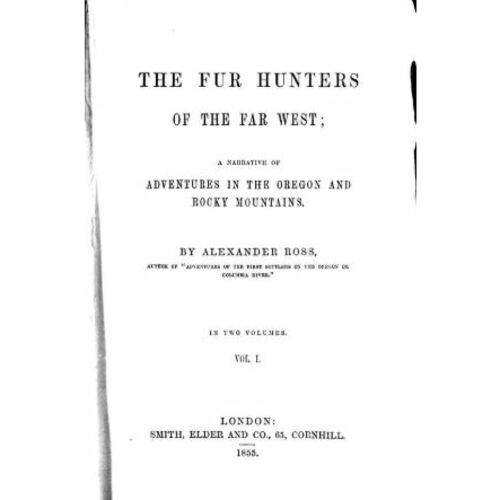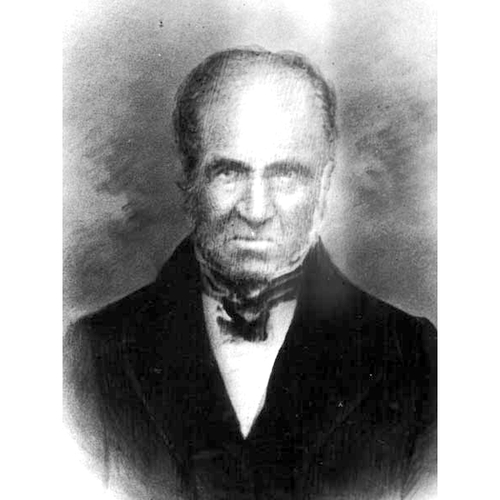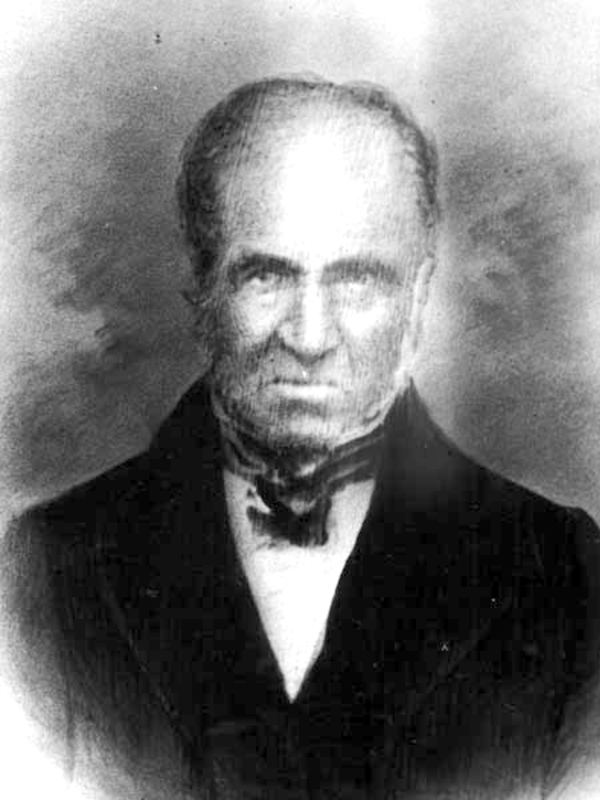
Source: Courtesy of Wikimedia Commons
ROSS, ALEXANDER, schoolmaster, fur trader, office holder, politician, justice of the peace, and author; b. 9 May 1783 in Morayshire, Scotland; d. 23 Oct. 1856 in the Red River settlement (Man.).
Alexander Ross was raised in Scotland on his father’s farm, Layhill, in the parish of Dyke. Little is known of his life before his departure from Greenock aboard the Countess of Darlington in 1804. He would appear to have had some formal education because, soon after his arrival at Quebec in July, he found employment as a schoolmaster. The following year he left for Upper Canada and again secured a position as teacher, in Glengarry County. By 1809 he had saved enough to buy 300 acres of land. He had not immigrated to British North America, however, to become a yeoman or an underpaid schoolmaster; he had come to make his fortune, and in the Canadas it was the fur trade with its excitement and prospect of wealth that lured the young. In 1810, presumably in Montreal, Ross met Wilson Price Hunt of the Pacific Fur Company, and soon afterwards signed up as a clerk. On 20 July he left Montreal for New York with two of the company’s partners, Alexander MacKay* and Duncan McDougall*, and a group of clerks and voyageurs. In September the party sailed for the Pacific northwest coast aboard the Tonquin. The voyage was a stormy one, as much the result of the abrasive character of the captain, Jonathan Thorn*, as of the weather of the south Atlantic. The vessel made a short stop at the Falkland Islands to take on water, and Ross was among the group of eight or nine passengers left behind by the captain when the Tonquin lifted anchor on 11 December. Only after struggling for several hours against a rough sea in a boat designed for half their number did the party succeed in rejoining the vessel. According to Ross, the rescue had only been made possible by one of the PFC partners, Robert Stuart, who forced the captain at gunpoint to turn back for the boat.
The Tonquin arrived late in March 1811 at the mouth of the Columbia River, where the PFC party established Fort Astoria (Astoria, Oreg.). On 22 July, Ross went up the Columbia with a trading expedition under David Stuart. The PFC men were accompanied for a short distance by David Thompson, of the North West Company, who had arrived at the fort earlier in the month. At the junction of the Okanagan and Columbia rivers a small post, Fort Okanagan (Wash.), was built and, while the rest of the party continued north in search of furs, Ross was left behind to trade with the Indians around the fort. He remained at this post for the next few years and there took an Okanagan woman, Sally*, as his country wife.
When the NWC purchased the PFC establishment in the Columbia in 1813, Ross joined that company and took charge of the northern posts, working out of Fort Okanagan. In 1816, appointed second in command to James Keith, who was charged with the trade on the Pacific coast, Ross spent a year at Fort Astoria, renamed Fort George by the NWC. He found the interior more to his liking, however, and in 1817 procured an assignment to Fort Thompson (Kamloops, B.C.). The following year he left with an expedition under Donald McKenzie to establish Fort Nez Percés (Walla Walla, Wash.), which was to be the departure point for trapping and trading in the Snake River country to the south. When McKenzie left with the first expedition in September, Ross was instructed to complete the construction of the post and to man it during the winter. He remained there during McKenzie’s subsequent expeditions in 1819–20 and 1820–21, and after the union of the NWC and the Hudson’s Bay Company in 1821.
The first expedition into the Snake country under the HBC was conducted by Finan McDonald in 1823. Ross was given charge of the expedition in 1824 by the HBC’s Northern Department council and set out from Flathead Post (Mont.) on 10 February with 54 men and 231 horses, equipped with 206 traps and 62 guns. After Ross’s first expedition HBC governor George Simpson, who visited the Columbia district in 1824–25, was convinced that Ross did not have the talent to implement his policy of trapping out the Snake country and Peter Skene Ogden was instructed to lead later expeditions.
Ross had been contemplating settling in the Red River colony since 1823 and, like so many who found themselves redundant after Simpson’s careful pruning, he moved there with his wife and four children in 1825. He settled on a 100-acre grant of land near the junction of the Red and Assiniboine rivers, and in the next years he became a prominent member of the community. Upon his arrival Ross found the settlement in a state of starvation and took to the plains near Pembina (N.Dak.) with Andrew McDermot* to keep himself and his family supplied with fresh meat. Ross, whom Simpson always thought lacked loyalty to the HBC, traded meat and corn with the Americans, Indians, and settlers, and in the following spring he began to run York boats from Red River to Hudson Bay. Labelled a “petty trader” by the HBC officers, he shipped company goods out of the colony and brought in, both on his own account and for the HBC, trade goods and general merchandise. His brigades attracted the influential men of the settlement, and Louis Guiboche, Cuthbert Grant, and the sons of retired chief factors William Hemmings Cook* and James Bird were among those who joined him. Ross does not seem to have continued his trading activity beyond the late 1820s; he may have capitulated to growing competition from other free traders or to pressures from Simpson who sought to discourage trade with the Americans at Pembina.
Ross was one of the few men in the colony capable of tackling its increasingly complicated administrative problems, and over the years, despite his unpopularity with Simpson, he assumed several positions of responsibility. In 1835 he was appointed sheriff of Assiniboia and on 12 February he attended the Council of Assiniboia as an invited observer. At this meeting he was named to the committee of public works with McDermot, Robert Logan*, John Bunn*, and Simpson, and was appointed commander of the Volunteer Corps of 60 men created by the council to maintain order in the colony. On 13 June 1836 he was sworn in as councillor himself. The internal workings of the council are not known since its minutes do not indicate the precise contributions of each member. It would seem, however, that Ross exerted a moderating influence. For example, the difficult and bigoted recorder, Adam Thom*, complained throughout the 1840s that Ross refused to enforce the HBC’s monopoly over the trade in furs and the prohibition against free trade. In 1845 Ross argued with Thom and a few of the other magistrates. He claimed that they were excessively unreasonable and unjust in expecting the police to enforce the monopoly provision of the HBC charter to the letter, and as sheriff he refused to press the volunteer mixed-blood police to do so. It is probable that most of the officers and men were themselves involved in the free trade and prosecution would have led to revolt. Ross’s own connection with the free traders has not been determined, but Thom believed he was involved. When James Green, an American free trader who was to marry Ross’s daughter Isabella in 1845, was prosecuted late in 1844, Ross attempted an equivocal stance.
Ross accumulated several other positions in the civil administration of the colony. In 1837 he was named magistrate for the Red River middle district. With the modification of the judicial structure of the colony effected by the HBC in 1839 he was named sheriff, with Cuthbert Grant, and in that capacity acted as chief officer in the supreme court. In 1843 he was appointed governor of the new jail with an annual allowance of £30 and two years later he added to his charge that of collector of customs duty following Bird’s resignation from that office. He was appointed by council to the committee of finance, with Bunn, Thom, and George Marcus Cary, in 1847. Ross’s lenient position on free trading put him at odds with Thom and solidified his support among the Métis. The conflict between Ross and Thom came to a head in February 1850 when the case of Matheson v. Thom was heard in the General Quarterly Court. Ross refused to sit on the bench and Governor William Bletterman Caldwell* presided over the court. According to Ross, Thom conducted his own defence “stamping, ranting and lecturing some two hours, insulting the magistrates and turning the jury out of the box.” When Thom apparently stormed out of the courtroom in contempt of court, Caldwell failed to bring him to order, but promptly called Ross to order when he stated that neither law nor justice existed in the colony. Ross and the other magistrates subsequently refused to sit on the bench with the governor and in July they drafted a petition, which was signed by all of the lay councillors and more than 500 others, addressed to Eden Colvile*, the recently appointed governor of Rupert’s Land, calling upon him to assume Caldwell’s responsibilities at Red River. Ross had in the mean time resigned both as sheriff and as councillor, and in October 1851 he resigned as governor of the jail.
Ross’s greatest interest, and the concern of many of his contemporaries, was what was known in Red River as the “Presbyterian question.” This issue, which consumed much of Ross’s attention in his last years, had its roots in the migration of Scottish settlers to the area in 1812. Brought to North America by Lord Selkirk [Douglas*], they had been promised a clergyman of their own faith and language – Presbyterian and Gaelic. In the absence of their own minister, most of the Presbyterians submitted to the forms and practices of the Church of England.
After the departure of the first Church of England missionary, John West*, his successors, David Thomas Jones* and William Cockran*, eventually modified their liturgy to accommodate the Scottish settlers and were informally low church and without Catholic pretension. The Presbyterians nevertheless continued to petition the HBC for a clergyman and in June 1844 Ross, Logan, and James Sinclair presented their case to Governor Simpson. The company was asked to contribute to the support of a minister. Compensation both for the property originally set aside for a Presbyterian church – upon which the Anglican Upper Church (St John’s) had been built – and for the contribution made by the Presbyterian settlers over the years to the Anglican parish was also demanded. In the fall of 1850, after the intervention of the reverends Robert Burns* and William Rintoul of the Presbyterian Church of Canada (Free Church), Governor Colvile offered the Red River Presbyterians a glebe at Frog Plain and £150 for the construction of their own church. At the same time the Anglican bishop of Rupert’s Land, David Anderson*, agreed to purchase 28 pews, at £2 each, from the seceding members of the Upper Church. In September 1851 the first Presbyterian minister, John Black*, arrived in the settlement. Although it is difficult to determine how many colonists left the Anglican Church after Black started his services, it is known that only 80 to 90 communicants were left at the Upper Church; 70 remained at the Middle Church (St Paul’s), where before there had been approximately 200. Ross himself estimated at 300 the number of Presbyterians who rallied to their own church. When, in 1852, Anderson threatened to prevent burial by any but Anglican rite in the Upper Church graveyard, where the Scots had been burying their dead since their arrival in the colony, Ross successfully called upon the HBC to intervene in favour of an open churchyard. None the less, feelings between the Anglican and Presbyterian communities had become so vicious that relations were never to be the same as they had been before.
Ross and his wife, Sally, were married by Christian rite in the Upper Church on 24 Dec. 1828, and at their home, Colony Gardens, they raised a family of at least 13 children. There is every indication that their children were aware of their racial disadvantage. Ross himself regarded the mixed-bloods as genetically inferior, and felt that only with the greatest effort could they be a credit to their heritage. The children were all too aware that “Mama” was only an Indian and they had to remind themselves that she nevertheless deserved their love and respect. The Ross children, pressed by their father to preserve their station, did well. William was appointed assistant sheriff and governor of the jail in 1851, to succeed his father, and in 1853 was sworn in as councillor of Assiniboia. He also held the offices of petty judge, auditor of public accounts, and postmaster before his premature death in 1856. James* attended the University of Toronto and during the events of 1869–70 [see Louis Riel*] he was a principal spokesman for the English-speaking settlers. Henrietta Ross married John Black, and another daughter, Mary, married the Presbyterian minister George Flett. These marriages were exceptional for mixed-blood women, and in fact Black’s marriage to Ross’s daughter in 1853 created quite a stir in the colony. Jemima Ross married William Coldwell, who with William Buckingham founded the Nor’Wester, the first newspaper in the settlement, in 1859.
While at Colony Gardens, Ross also turned his talents to writing and, as the author of three books, he was the most prolific writer in the pre-1870 northwest. His first book, Adventures on the Columbia, published in 1849, carefully documented his voyage to the Columbia in 1810–11 and his years in the employ of the PFC. With the narratives of Gabriel Franchère* and Ross Cox, this volume is one of the three first-hand accounts of the enterprise of John Jacob Astor. His second book, The fur hunters of the far west, was also largely written from his experiences in the fur trade. Published in 1855, this work covers his years with the NWC and the HBC up to 1825. The third volume, The Red River settlement, appeared in 1856, shortly before his death. In this last book, the best single piece of writing on the Red River, it is evident that Ross believed that the motley, quixotic settlement at the forks of the Red and Assiniboine rivers had a predestined purpose. To Ross it was a civilized nucleus in the wilderness, whose primary function was to bring civilization and Christ to the “heathen.” Although Ross felt that his years in the Oregon country were spent in a smothering wilderness, he believed his years in Red River were filled with divine purpose. He never tried to escape his exile in the west as did so many fur traders who fled eagerly upon retirement to the Canadas or back to Great Britain. Red River was the catalyst that would convert the wilderness and Ross of course by extension felt he must function as “the example.” This conviction might explain his tireless devotion to his community, his church, and the upbringing of his mixed-blood children.
Alexander Ross is the author of Adventures on the Columbia; The fur hunters of the far west; a narrative of adventures in the Oregon and Rocky mountains (2v., London, 1855); The Red River settlement: its rise, progress and present state; with some account of the native races and its general history, to the present day (London, 1856; repr. Minneapolis, Minn., 1957; repr. Edmonton, 1972); “Journal of Alexander Ross – Snake country expedition, 1824,” ed. T. C. Elliott, Oreg. Hist. Soc., Quarterly (Portland), 14 (1913): 366–88; and “Letters of a pioneer,” ed. George Bryce, Man., Hist. and Scientific Soc., Trans. (Winnipeg), no.63 (1903). Some bibliographies also attribute the fictional Selma: a tale of the sixth Crusade (London, 1839) to him.
PAC, MG 25, 62. PAM, HBCA, A.34/1: f.107; B.202/a/1; B.235/a/7–12; D.5/1–29; E.16/2; MG 2, B2; B4-1; C3; C14; MG 7, B4-1, 21 Dec. 1853; B7-1, 8 Aug. 1830; C12. Canadian North-West (Oliver), vol.1. Cox, Adventures on the Columbia. Docs. relating to NWC (Wallace). HBRS, 3 (Fleming); 13 (Rich and Johnson); 19 (Rich and Johnson). Simpson, Fur trade and empire (Merk; 1968). Quebec Gazette, 19 July 1804. George Bryce, “Alexander Ross,” Canadian Magazine, 49 (May–October 1917): 163–68; “Alexander Ross, fur trader, author and philanthropist,” Queen’s Quarterly (Kingston, Ont.), 11 (1903–4): 46–56. R. St G. Stubbs, “Law and authority in Red River,” Beaver, outfit 299 (summer 1968): 17–21.
Cite This Article
Frits Pannekoek, “ROSS, ALEXANDER,” in Dictionary of Canadian Biography, vol. 8, University of Toronto/Université Laval, 2003–, accessed November 19, 2024, https://www.biographi.ca/en/bio/ross_alexander_8E.html.
The citation above shows the format for footnotes and endnotes according to the Chicago manual of style (16th edition). Information to be used in other citation formats:
| Permalink: | https://www.biographi.ca/en/bio/ross_alexander_8E.html |
| Author of Article: | Frits Pannekoek |
| Title of Article: | ROSS, ALEXANDER |
| Publication Name: | Dictionary of Canadian Biography, vol. 8 |
| Publisher: | University of Toronto/Université Laval |
| Year of publication: | 1985 |
| Year of revision: | 1985 |
| Access Date: | November 19, 2024 |


